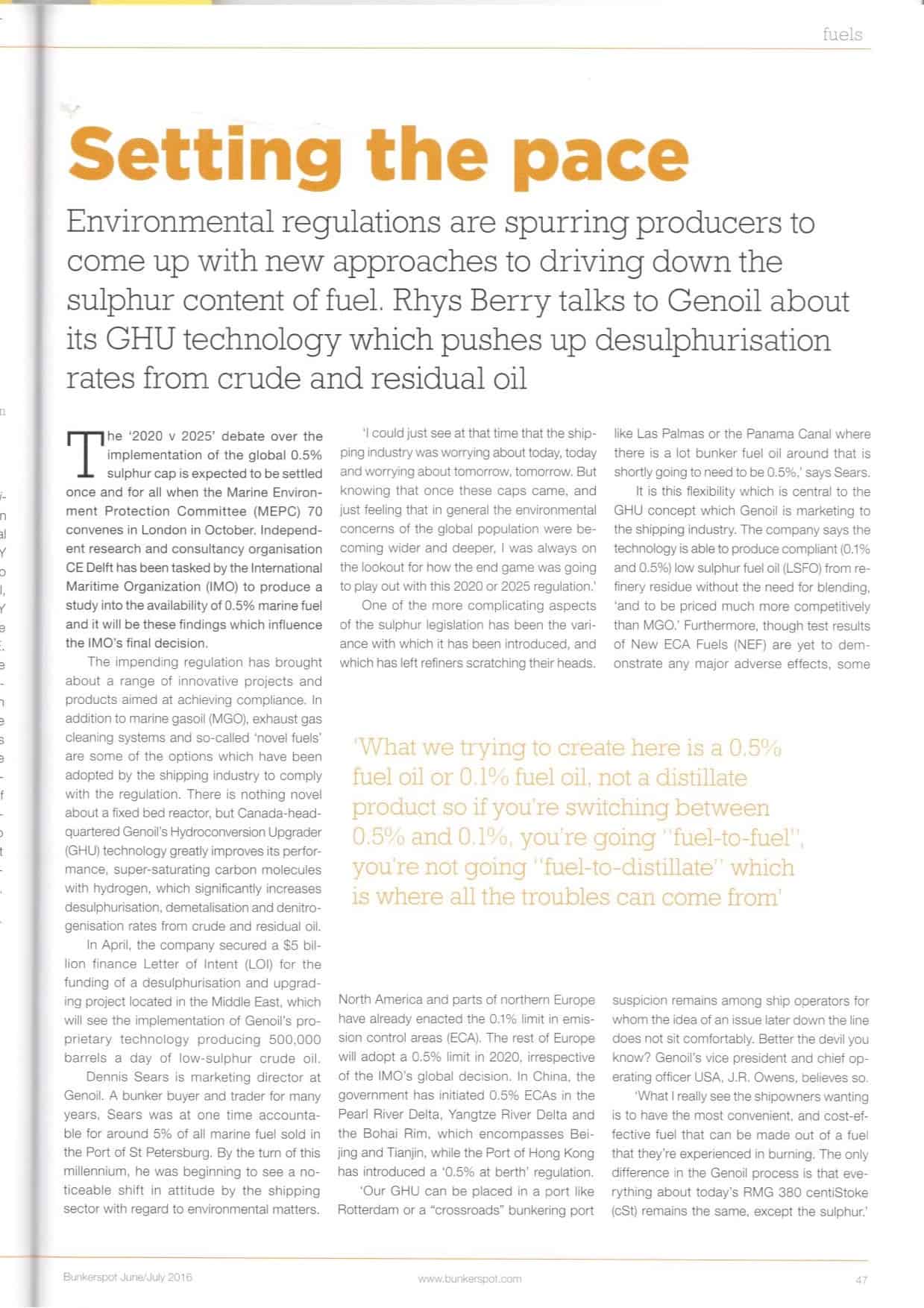Environmental regulations are spurring producers to come up with new approaches to driving down the sulphur content of fuel. Rhys Berry talks to Genoil about its GHU technology which pushes up desulphurisation rates from crude and residual oil
Environmental regulations are spurring producers to come up with new approaches to driving down the sulphur content of fuel. Rhys Berry talks to Genoil about its GHU technology which pushes up desulphurisation rates from crude and residual oil
The ‘2020 v 2025’ debate over the implementation of the global 0.5% sulphur cap is expected to be settled once and for all when the Marine Environment Protection Committee (MEPC) 70 convenes in London in October. Independent research and consultancy organisation CE Delft has been tasked by the International Maritime Organization (IMO) to produce a study into the availability of 0.5% marine fuel and it will be these findings which influence the IMO’s final decision.
The impending regulation has brought about a range of innovative projects and products aimed at achieving compliance. In addition to marine gasoil (MGO), exhaust gas cleaning systems and so-called ‘novel fuels’ are some of the options which have been adopted by the shipping industry to comply with the regulation. There is nothing novel about a fixed bed reactor, but Canada-headquartered Genoil’s Hydroconversion Upgrader (GHU) technology greatly improves its performance, super-saturating carbon molecules with hydrogen, which significantly increases desulphurisation, demetalisation and denitrogenisation rates from crude and residual oil.
In April, the company secured a $5 billion finance Letter of Intent (LOI) for the funding of a desulphurisation and upgrading project located in the Middle East, which will see the implementation of Genoil’s proprietary technology producing 500,000 barrels a day of low-sulphur crude oil.
Dennis Sears is marketing director at Genoil. A bunker buyer and trader for many years. Sears was at one time accountable for around 5% of all marine fuel sold in the Port of St Petersburg. By the turn of this millennium, he was beginning to see a noticeable shift in attitude by the shipping sector with regard to environmental matters.
Bunkerspot June/July 2016 ‘I could just see at that time that the shipping industry was worrying about today, today and worrying about tomorrow, tomorrow. But knowing that once these caps came, and just feeling that in general the environmental concerns of the global population were becoming wider and deeper, I was always on the lookout for how the end game was going to play out with this 2020 or 2025 regulation.’ One of the more complicating aspects of the sulphur legislation has been the variance with which it has been introduced, and which has left refiners scratching their heads.
North America and parts of northern Europe have already enacted the 0.1% limit in emission control areas (ECA). The rest of Europe will adopt a 0.5% limit in 2020. irrespective of the IMO’s global decision. In China, the government has initiated 0.5% ECAs in the Pearl River Delta, Yangtze River Delta and the Bohai Rim, which encompasses Beijing and Tianjin, while the Port of Hong Kong has introduced a ‘0.5% at berth’ regulation. ‘Our GHU can be placed in a port like Rotterdam or a “crossroads” bunkering port like Las Palmas or the Panama Canal where there is a lot bunker fuel oil around that is shortly going to need to be 0.5%,’ says Sears.
It is this flexibility which is central to the GHU concept which Genoil is marketing to the shipping industry. The company says the technology is able to produce compliant (0.1% and 0.5%) low sulphur fuel oil (LSFO) from refinery residue without the need for blending, ‘and to be priced much more competitively than MGO.’ Furthermore, though test results of New ECA Fuels (NEF ) are yet to demonstrate any major adverse effects, some suspicion remains among ship operators for whom the idea of an issue later down the line does not sit comfortably. Better the devil you know? Genoil’s vice president and chief operating officer USA, J R. Owens, believes so. ‘What I really see the shipowners wanting is to have the most convenient, and cost-effective fuel that can be made out of a fuel that they’re experienced in burning. The only difference in the Genoil process is that everything about today’s RMG 380 centiStoke (cSt) remains the same, except the sulphur.’
Owens says the advantage of the GHU is down to the confidence that ship operators have with using heavy fuel oil (HFO) over many years.
‘With all these people trying to take these different streams and blend down to the 0.1% ECA regulations, there’s no consistency between ports,’ says Owens. ‘Genoil’s process would bring consistency within the ports.’
In the most part, ship operators have opted for MGO to ensure regulatory compliance. Liquefied natural gas (LNG) and the emergence of NEFs from major players such as Exxon Mobil, Lukoil, BP, Shell and Chemoil have also played a supporting role while others have gone down the route of exhaust gas cleaning systems (EGCS), thus enabling them to continue to operate on HFO. The latter, suggests Sears, will become less significant when the global sulphur cap eventually enters into force.
‘On the scrubber side, on shortsea routes they’ve come to pass but mainly because those are the areas where the ECA regulation started much sooner and there was no other alternative. Once Genoil’s technology is widely available to produce fuel around the world, I see scrubber use declining on vessels.’
What the uptake rate of emission abatement technology proves to be remains to be seen, but most of the available compliance options are derived from crude oil refining processes. Of course, bunker fuel is not particularly high up the refinery pecking order. While liquid petroleum gas (LPG) and distillates represent some of the more profitable products, HFO often yields losses ‘Refiners don’t produce bottoms – they want to produce jet fuel, gasoline and gasoil, so when it comes to the bottoms. they want someone else to step into the game,’ says Sears.
Initially, Genoil struggled to convey the economic benefits of the investment, says Owens. However, with the recent line of credit, he and Sears are convinced that the company’s marketing process is going to be much more favourable. Sears recalls a chance encounter at a Rotterdam bunker conference approximately 10 years ago which left a lasting impression.
‘During the evening water cruise around the Rotterdam harbour, I was at a table with one of the guys who was with EUROPIA [a non-profit organisation that represents the downstream sector (refining and marketing) of Europe’s oil industry. He made a statement that I always remembered: “Governments can tell refiners what they can sell Bwkerspot June/July 2016 but they can’t tell them what they can make.”‘ As the 0.5% limit looms closer, Sears is confident that the market will be demanding the product and the refiners are going to supply it. ‘The refiners have yet to find a cost effective method of extracting sulphur from fuel oil, and it is not a commercial priority for them. Other non-refining companies may look into building a GHU-type technology, but we have a march on the market. Our technology does not need to be sited at a refinery, in fact all we need is the HFO input. and we can produce compliant, cost effective low sulphur fuel from the get-go, which shipowners and fuel suppliers will demand in abundance.’ The company is also keen to distance itself from the distillate market and thus any issues regarding fuel switcl1ing. ‘What we trying to create here is a 0.5% fuel oil or 0.1% fuel oil, not a distillate product so if you’re switching between 0.5% and 0.1%, you’re going “fuel-to-fuel”, you’re not going “fuel-to-distillate”, which is where all the troubles can come from,’ says Sears. Essentially, the Genoil process is taking a product that is a by-product below crude oil economics and turning it into a crack spread – the differential between crude oil and the petroleum products produced from it – economic.
‘With our process, when you take a 4% sulphur bunker fuel and reduce it to 0.1% sulphur fuel you’re taking out the sulphur and the by-product is then a recoverable expense,’ says Owens. ‘When you get down to that last four tenths you’ve taken so much out of the product already that, in my opinion, it’s a very minimal difference in cost to remove that last four tenths of sulphur.’ Ostensibly, the Genoil business model is contingent on a 2020 vote and consensus suggests that will happen. Despite a clear desire and expectation of a 2020 decision, Genoil says it is well-equipped to deal with the possibility of a five-year deferral.
‘Genoil is basically proceeding on two tracks – we’re both interested in the bunker side and the crude oil side,’ explains Sears. Carbon-based products have quite literally fueled China’s industrialisation in recent years. In 2012, China was responsible for 25% of global carbon emissions. By 2015, however. the country’s carbon output was starting to come down – partly due to its economic slowdown – but also in part to government policies. ‘One of the reasons that the Chinese bank is involved in this is that there is a need to get sulphur out of crude oil for all the other uses where oil is burned, not just ships at sea,’ says Sears. ‘If the 2025 number happens, which I really doubt at this point, Genoil still has other avenues to go forward on regarding air quality and the fact that most the nations in the world are wanting sulphur out of what’s being burned.’ And if it is 2025? ‘I don’t see it as a horrible event if the number goes back from 2020 to 2025,’ says Sears. ‘It would be preferable, of course, if it stays at 2020! In any case, Genoil originally came into existence to get sulphur out of crude oil, however our technology transcends markets, and we are delighted that we also have a solution that is applicable to the shipping industry, meeting the demand for cost effective, low sulphur fuel oil at a time when shipowners are under significant pressure to adapt to new legislation and maintain profitability in tough economic times.’


